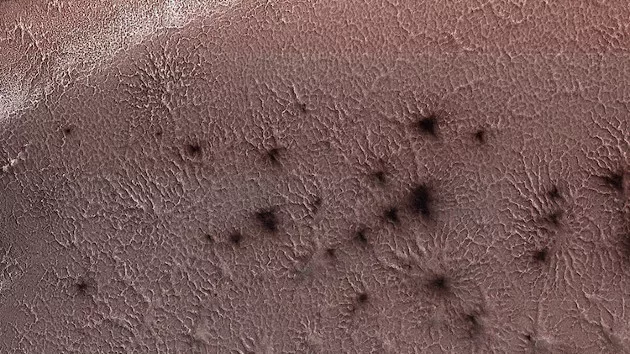(NEW YORK) — Over two decades since NASA researchers first saw images of mysterious, spider-like formations across the southern hemisphere of Mars, the space agency announced it’s recreated the planet’s “spiders” here on Earth.
Dubbed “araneiform terrain,” the formations span over a half-mile long and have hundreds of branches that resemble spider legs, according to NASA.
Theories surrounding the Red Planet’s “spiders” date back to 2003, when researchers got a glimpse of the terrain via Mars orbiters, with many believing they are formed through carbon dioxide ice, which doesn’t occur naturally on Earth.
To confirm this hypothesis, researchers from NASA’s Jet Propulsion Laboratory (JPL) in Southern California said they recreated the formation process in a simulated Mars environment that mimicked the planet’s air pressure and temperature.
The simulation chamber — called the Dirty Under-vacuum Simulation Testbed for Icy Environments, or DUSTIE for short — uses liquid nitrogen to reach temperatures as low as minus 301 degrees Fahrenheit, according to NASA.
Results from the five-year study were published this month in The Planetary Science Journal.
“The spiders are strange, beautiful geologic features in their own right,” JPL researcher Lauren Mc Keown said in a Sept. 11 press release. “These experiments will help tune our models for how they form.”
Researchers found that when sunlight heats soil underneath slabs of carbon dioxide ice that form on the surface of Mars each winter, the soil absorbs the heat and causes the ice closest to it to turn directly into carbon dioxide gas, according to NASA.
This process, called “sublimation,” causes the ice to crack and brings dust and soil to the surface of the ice, according to the agency.
“When winter turns to spring and the remaining ice sublimates, according to the theory, the spiderlike scars from those small eruptions are what’s left behind,” researchers wrote in the study.
To recreate the formation process in DUSTIE, researchers said they analyzed simulated Mars soil that was contained and submerged into a liquid nitrogen bath.
Matching the reduced air pressure to match that of Mars’ southern hemisphere, researchers said they watched as carbon dioxide gas then flowed into the chamber and condensed into ice over a period of three to five hours.
Researchers then placed a heater inside the chamber below the simulated soil to warm it up and crack the ice.
Mc Keown said she was “ecstatic” when the theories were proven by seeing a carbon dioxide gas plume erupt from within the Mars soil simulation.
Lab experiments and orbiter images are the closest look NASA has at these unique Martian spiders, with the Curiosity and Perseverance rovers exploring far from the region where they occur.
So far, a spacecraft has yet to land on the Red Planet’s southern hemisphere.
Copyright © 2024, ABC Audio. All rights reserved.

